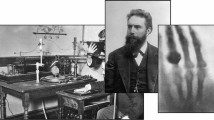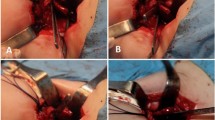Abstract
Purpose
The aim of this study was to analyse the results of treatment of sonographically diagnosed type IIb developmental hip dysplasia and to identify residual hip dysplasia using clinical and radiological assessment.
Methods
We retrospectively reviewed the data of 49 children (59 type IIb and 39 type I hips, according to Graf’s monographic classification) treated in abduction braces. The mean age was 9.1 years (range 4–15) at latest follow-up.
Results
According to the clinical classification of Mckay in Barrett’s modification, all the type I and type IIb hips had very good results. No statistical differences were found between type I and IIb hips when comparing both measured radiological parameters and radiological results according to the Severin classification at latest follow-up. Using our criteria (two or more radiological parameters were outside of their normal range), 12 out of 49 type IIb hips demonstrated persistent dysplasia. Of the 12 hips, eight sonograms were normal at the end of treatment and four patients failed to normalise. No type I hips demonstrated two or more abnormal radiographic parameters at latest follow-up.
Conclusions
Despite obtaining normal sonograms at the end of treatment, some children with type IIb dysplasia may demonstrate radiographic evidence of persistent hip dysplasia over a longer follow-up period. Our results suggest that these children should be monitored until skeletal maturity.

Similar content being viewed by others
References
Wedge JH, Wasylenko MJ (1979) The natural history of congenital disease of the hip. J Bone Joint Surg Br 3:334–338
Cooperman DR, Wallensten R, Stulberg SD (1983) Acetabular dysplasia in the adult. Clin Orthop Relat Res 175:79–85
Dornacher D, Cakir B, Reichel H, Nelitz M (2010) Early radiological outcome of ultrasound monitoring in infants with developmental dysplasia of the hips. J Pediatr Orthop B 19:27–31
Synder M, Niedzielski K, Grzegorzewski A (2003) Ultrasonografia stawu biodrowego noworodków i niemowląt. Ortop Traumatol Rehabil 5:717–721
Graf R (1980) The diagnosis of congenital hip-joint dislocation by the ultrasonic Combound treatment. Arch Orthop Trauma Surg 97:117–133
Barrett WP, Staheli LT, Chew DE (1986) The effectiveness of the Salter innominate osteotomy in the treatment of congenital dislocation of the hip. J Bone Joint Surg Am 68:79–87
Tönnis D (1987) Congenital dysplasia and dislocation of the hip in children and adults. Springer-Verlag, Berlin
Severin E (1941) Contribution of the knowledge of congenital dislocation of the hip joint. Late results of closed reduction and arthrographic studies of recent cases. Acta Chir Scand 84(Supp 63):1–142
Bialik V, Bialik GM, Blazer S, Sujov P, Wiener F, Berant M (1999) Developmental dysplasia of the hip: a new approach to incidence. Pediatrics 103:93–99
Eastwood DM (2003) Neonatal hip screening. Lancet 361:595–597
Feldman DS (1999) Re: How to avoid missing congenital dislocation of the hip. Lancet 354:1490–1491
Rachbauer F, Sterzinger W, Klestil T, Krismer M, Frischhut B (1994) Acetabular development following early treatment of hip dysplasia by Pavlik harness. Arch Orthop Trauma Surg 113:281–284
Rafique A, Set P, Berman L (2007) Late presentation of developmental dysplasia of the hip following normal ultrasound examination. Clin Radiol 62:181–184
Ihme N, Altenhofen L, von Kries R, Niethard FU (2008) Sonographisches Hüftscreening in Deutschland. Ergebnisse und Vergleichmitanderen Screeningverfahren. Orthopade 37:541–549
Graf R (2006) Hip sonography. Diagnosis and management of infant hip dysplasia, 2nd edn. Springer-Verlag, Berlin
Gardiner HM, Dunn PM (1990) Controlled trial of immediate splinting versus ultrasonographic surveillance in congenitally dislocatable hips. Lancet 336:1553–1556
Paton RW, Hinduja K, Thomas CD (2005) The significance of at-risk factors in ultrasound surveillance of developmental dysplasia of the hip. A ten-year prospective study. J Bone Joint Surg Br 87:1264–1266
Roovers EA, Boere-Boonekamp MM, Mostert AK, Castelein RM, Zielhuis GA, Kerkhoff TH (2005) The natural history of developmental dysplasia of the hip: sonographic findings in infants of 1–3 months of age. J Pediatr Orthop B 14:325–330
Osarumwense D, Popple D, Kershaw IF, Kershaw CJ, Furlong AJ (2007) What follow-up is required for children with a family history of developmental dysplasia of the hip? J Pediatr Orthop B 16:399–402
Conflict of interests
The authors declare that they have no conflict of interest.
Funding
The article was not financially supported.
Author information
Authors and Affiliations
Corresponding author
Rights and permissions
About this article
Cite this article
Sibiński, M., Adamczyk, E., Higgs, Z.C.J. et al. Hip joint development in children with type IIb developmental dysplasia. International Orthopaedics (SICOT) 36, 1243–1246 (2012). https://doi.org/10.1007/s00264-011-1447-8
Received:
Accepted:
Published:
Issue Date:
DOI: https://doi.org/10.1007/s00264-011-1447-8




